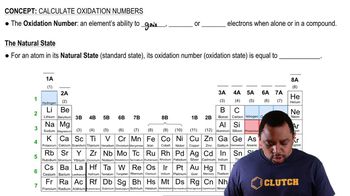Here are the essential concepts you must grasp in order to answer the question correctly.
Oxidation Numbers
Oxidation numbers are a way to keep track of electron transfer in chemical reactions. They represent the hypothetical charge an atom would have if all bonds were ionic. The rules for assigning oxidation numbers include that the oxidation number of an element in its elemental form is zero, and for monoatomic ions, it equals the charge of the ion.
Recommended video:
Polyatomic Ions
Polyatomic ions are ions composed of two or more atoms that are covalently bonded together and carry a net charge. In the case of the nitrate ion (NO3-), it consists of one nitrogen atom and three oxygen atoms, collectively carrying a -1 charge. Understanding the structure and charge of polyatomic ions is essential for correctly assigning oxidation numbers.
Recommended video:
Polyatomic Ion Variations
Rules for Assigning Oxidation States
There are specific rules for assigning oxidation states that help in determining the oxidation number of each element in a compound or ion. For example, oxygen typically has an oxidation number of -2, while nitrogen can vary. In the nitrate ion, the sum of the oxidation numbers must equal the overall charge of the ion, which is -1, guiding the assignment of oxidation states.
Recommended video:

 Verified step by step guidance
Verified step by step guidance


